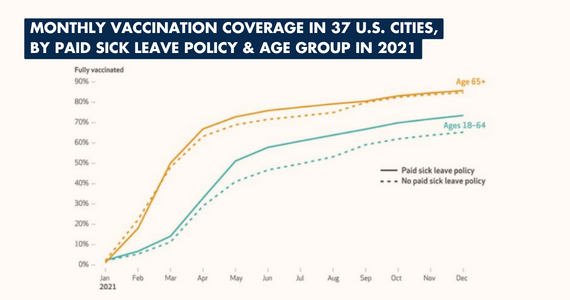Higher COVID-19 Vaccination and Narrower Disparities in U.S. Cities with Paid Sick Leave
 Authors’ analysis of vaccination data from the CDC and paid sick leave policy data from Temple’s State and City Earned Sick Leave Laws databases.
Authors’ analysis of vaccination data from the CDC and paid sick leave policy data from Temple’s State and City Earned Sick Leave Laws databases.
November 8, 2022
By Emily Gallagher
A new study published in the November issue of the journal Health Affairs and led by researchers at the Dornsife School of Public Health (DSPH) found that cities with paid sick leave policies have a 17 percent higher rate of COVID vaccination among working-age populations compared to cities without such policies.
Researchers also found stronger links between paid sick leave and vaccine coverage among the most socially vulnerable communities compared with the least socially vulnerable ones.
Researchers reviewed county-level data on vaccination rates and paid sick leave data from 37 major cities in the United States in 2021. They also examined associations with neighborhood social vulnerabilities using the CDC Social Vulnerability Index (SVI).
"Our research suggests that paid sick leave is a key policy to help increase COVID-19 vaccination rates and reduce vaccination disparities." - Lead author Alina Schnake-Mahl, ScD, MPH
Despite the U.S. being among the wealthiest countries, it lacks a national paid leave program. The paper notes that “the U.S. has a patchwork of city, county, and state laws that leave 21 percent of the civilian workforce without paid sick leave.” These inconsistencies can contribute to widening disparities in vaccine rates across communities.
“The populations who have been worst impacted by COVID-19 are the least able to take time off without pay to be vaccinated, and least likely to have access to paid sick leave from employers, making state and city paid sick leave policies especially important for them,” said lead author, Alina Schnake-Mahl, ScD, MPH, Assistant Professor in the Department of Health Management and Policy (HMP) and the Urban Health Collaborative at DSPH.
To prevent further COVID morbidity, the study suggests that federal legislators should approve paid sick leave to increase rates of vaccination and reduce health inequities. These policies allow workers time for receiving vaccines and recovering from potential adverse effects of vaccination.
“The United States is increasingly relying on vaccination to prevent COVID-19 deaths and hospitalizations. Our research suggests that paid sick leave is a key policy to help increase COVID-19 vaccination rates and reduce vaccination disparities, and we hope our findings provide further evidence to state and cities about the importance of enacting these policies,” said Schnake-Mahl.
Additional authors include Gabriella O’Leary, former MPH student in the Department of HMP and Urban Health Collaborative; Pricila H. Mullachery, Assistant Professor of Health Services Administration and Policy at Temple University; Alexandra Skinner, MPH, PhD student at Brown University School of Public Health; Jennifer Kolker, MPH, Clinical Professor in the Department of HMP and the Urban Health Collaborative, Associate Dean for Public Health Practice and External Relations, and Director of the Center for Public Health Practice; Ana V. Diez Roux, MD, PhD, MPH, Dana and David Dornsife Dean and Distinguished University Professor of Epidemiology; Julia R. Raifman, ScD, Assistant Professor at Boston University; and Usama Bilal, PhD, MPH, MD, Assistant Professor in the Department of Epidemiology and Biostatistics and the Urban Health Collaborative.
The full paper, "Higher COVID-19 Vaccination and Narrower Disparities in U.S. Cities with Paid Sick Leave Compared to Those Without," is now available in Health Affairs’ Volume 41.
READ THE FULL ARTICLE
Read the UHC's related policy brief (PDF)